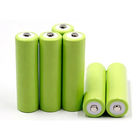|
Detail Information |
|||
Product Description
Long Cycle Life 26650 Sodium Ion Batteries with 3.2V Nominal Voltage
Product Description:
Sodium-ion batteries are an up-and-coming energy storage technology that could replace lithium-ion batteries. Rather than relying on lithium ions, they use sodium ions. Several benefits accompany these new batteries. The cost of sodium resources is cheaper than lithium, and there is a greater abundance of sodium to use. Furthermore, they have proven to deliver good safety characteristics, as well as the potential for high energy density and long cycle life.
Despite these advantages, further study and improvement are necessary for sodium-ion batteries to become a feasible, profitable option. Should their performance be successfully developed, sodium-ion batteries could have tremendous impacts in renewable energies, electric vehicles, and energy storage. Ultimately, they are part of a progression towards a more sustainable and efficient energy future.
Features:
Sodium-Ion Batteries: Cost-Effective, Safe and SustainableSodium-ion batteries are an attractive option for various applications due to their economical, safe and sustainable nature. Their greatest benefit is their cost-effectiveness; sodium is abundant and less expensive than lithium, making these batteries an economical alternative. In terms of safety, they exhibit excellent properties that reduce the risk of events such as thermal runaway or explosion.
Additionally, they have a high energy density, enabling them to store a large amount of energy without taking up too much space. Furthermore, their long cycle life makes them suitable for repeated charging and discharging. All these advantages make sodium-ion batteries a great candidate for renewable energy storage, electric vehicles, and grid-level energy storage. As a result, it can help create a more efficient and sustainable energy landscape for the future.
Technical Parameters:
| Attribute | Value |
|---|---|
| Safety | High |
| Cut-off Discharge Volt | 1.5V |
| Capacity | 2300mAh |
| Nominal Voltage | 3.2V |
| Energy Density | 140Wh/kg |
| Recharge Time | Short |
| Discharge rate | ≥4C |
| Operating Temperature | -20~55˚C |
| Cycle Life | Long |
| Size | 26650 |
Applications:
Sodium-ion batteries are growing in popularity as a possible substitute to traditional lithium-ion batteries. Their availability of low cost and abundant raw materials, such as sodium, renders them attractive for many applications.
Sodium-ion batteries can find uses in renewable energy storage systems, which allow for efficient retention of power generated from sources including solar and wind. Furthermore, they are also suitable for electric vehicles, providing an eco-friendly and sustainable energy source. Sodium-ion batteries can also be applied in grid-level energy storage, improving the reliability of the power grid. Due to their suitability for portable electronics and wearable devices, their range of applications continues to increase.
With continuous research and development, sodium-ion batteries are likely to contribute significantly to the aim of achieving a more energy-efficient future.
Packing and Shipping:
Sodium ion batteries are shipped in boxes or crates that are sized and designed to meet the specific dimensions and weight of the battery. Each shipment must also include the necessary labeling and documentation to ensure safe and efficient handling and delivery.
The batteries should be secured within the packaging material to prevent any shifting or movement during transit. Furthermore, the packaging should also be resistant to any potential damage caused by moisture or extreme temperatures. Additionally, any hazardous materials must be clearly labeled.
When shipping sodium ion batteries, the shipper must comply with all applicable transportation regulations and obtain the appropriate permits. The shipper should also provide the carrier with the necessary documents, such as a battery safety declaration form and a certificate of origin.
Furthermore, the shipper should ensure that the batteries are properly charged before shipping and the terminals are protected from any accidental short circuits. Additionally, the shipper should also coordinate with the carrier to ensure that the delivery is made in a timely manner.
FAQ:
-
Q1:What is a sodium-ion battery?
A1:A sodium-ion battery is a new type of battery technology that uses sodium ions as the charge carrier, instead of the traditional lithium ions. This battery has potential high energy density and longevity, as well as the use of safer and more environmentally friendly electrolytes.
Q2:What are the advantages of a sodium-ion battery?
A2:Sodium-ion batteries have some important advantages. Firstly, they have high energy density, which means they can store more electrical energy. Secondly, sodium-ion batteries charge faster and can be charged more quickly. In addition, sodium-ion batteries have a longer lifespan and can be used repeatedly for a longer time. Finally, sodium-ion batteries use safer and more environmentally friendly electrolytes, resulting in less environmental impact.
Q3:What are the differences between a sodium-ion battery and a lithium-ion battery?
A3:The main difference between a sodium-ion battery and a lithium-ion battery is that they use different anode and cathode materials. Lithium-ion batteries use lithium metal as the anode, while sodium-ion batteries use sodium metal as the anode. In addition, the electrolyte of a sodium-ion battery is also different from that of a lithium-ion battery.
Q4:What applications can a sodium-ion battery be used for?
A4:Sodium-ion batteries can be used in many applications. They can be used for power storage systems, such as in renewable energy systems like wind and solar energy. In addition, they can also be used in electric vehicles and electronic devices.
Q5:What are the future trends in the development of sodium-ion batteries?
A5:The future trends in the development of sodium-ion batteries are to improve energy density and lifespan, reduce costs, and achieve large-scale production. In addition, researchers are exploring new electrolyte and electrode materials to further improve the performance and safety of the battery.




